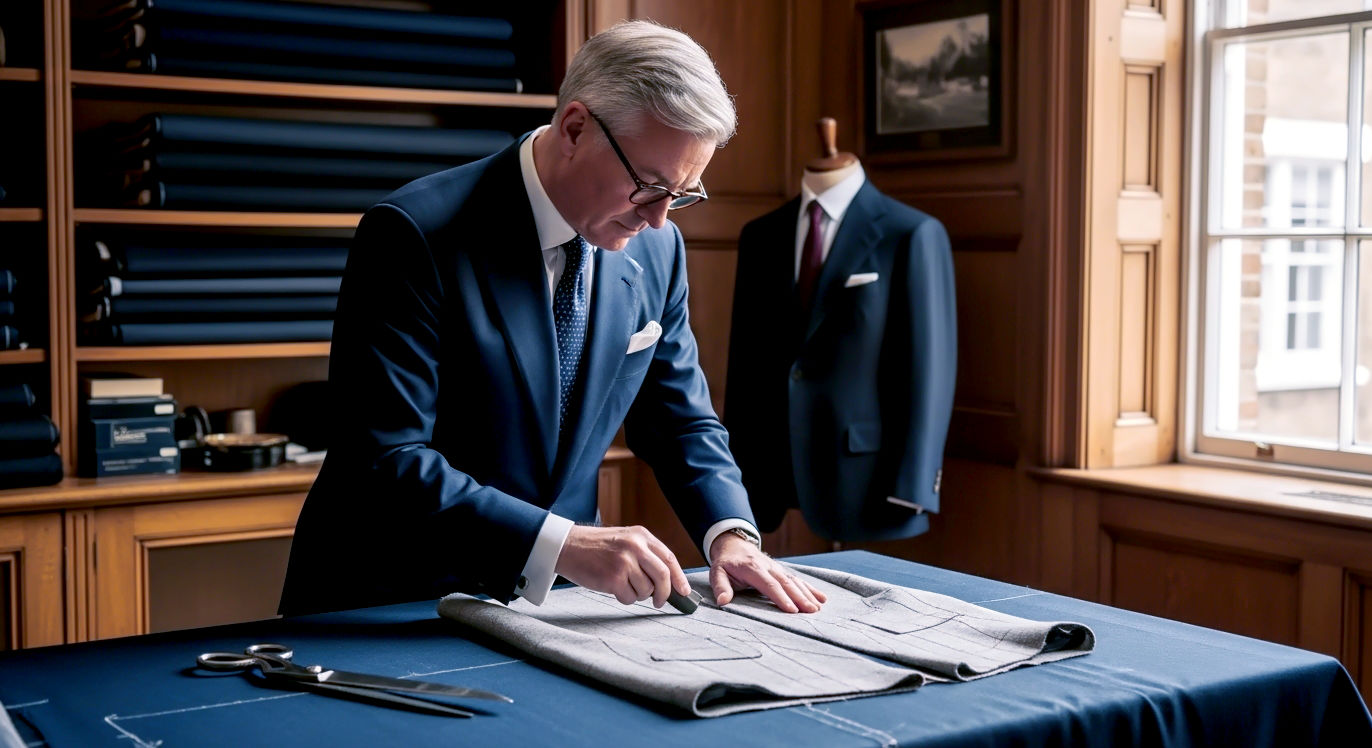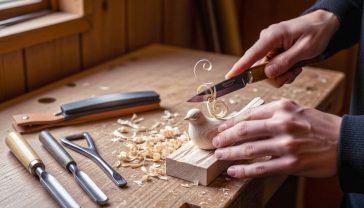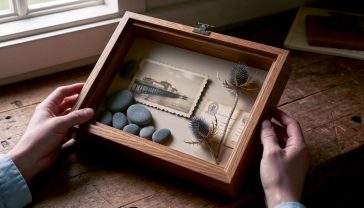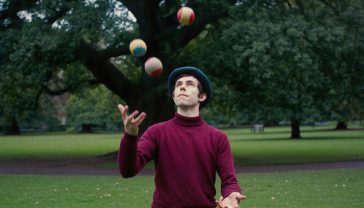Bespoke British Elegance: The Art of Savile Row Tailoring
Your definitive guide to Savile Row tailoring. Explore the history, uncover the secrets of the bespoke process, and meet the legendary houses of British elegance.

This post may contain affiliate links. If you make a purchase through these links, we may earn a commission at no additional cost to you.
Step onto a quiet street in London’s Mayfair, and you might feel like you’ve walked back in time. The elegant, stone-fronted buildings don’t shout for attention. There are no flashing signs or loud displays. But behind these understated doors lies a world of craftsmanship that has shaped how men have dressed for over two hundred years. This is Savile Row, the undisputed home of bespoke tailoring. It’s a place where cloth, thread, and skill come together to create something more than just a suit; they create a piece of wearable art, a second skin, an expression of true British elegance.
For generations, kings, film stars, rock legends, and titans of industry have made the pilgrimage to this small London street. They don’t come for a quick purchase off the peg. They come for an experience—a collaboration between client and cutter that results in a garment that fits perfectly, not just in measurement, but in character. But what exactly is ‘bespoke’? And how did this little corner of London become the global standard for men’s style?
This isn’t just a story about clothes. It’s a story about history, tradition, and a relentless pursuit of perfection that has kept Savile Row at the pinnacle of style, even as the world of fashion has twisted and turned around it. Let’s pull back the curtain on this uniquely British institution and discover the secrets stitched into the very fabric of Savile Row.
What is Savile Row? The Golden Mile of Tailoring
Before we dive into the nuts and bolts of how a bespoke suit is made, let’s get our bearings. What and where is Savile Row?
Put simply, Savile Row is a street in Mayfair, central London, famed for its traditional bespoke tailoring for men. It’s often called the “golden mile of tailoring” because it’s home to the most skilled and historic tailoring houses in the world. When someone talks about a “Savile Row suit,” they’re talking about the highest standard of tailoring imaginable.
The street itself was built between 1731 and 1735 and was named after Lady Dorothy Savile, the wife of the 3rd Earl of Burlington. Initially, it was a place for posh military officers and their families to live. These officers needed top-notch uniforms, and tailors, naturally, set up shop nearby to serve them. This connection with military precision and quality set the standard for everything that followed.
Over the years, the tailors of Savile Row moved from making immaculate uniforms to crafting flawless civilian clothing. By the 19th century, figures like Beau Brummell, a friend of the Prince Regent (later King George IV) and the original superstar of men’s fashion, championed the understated, perfectly tailored look that Savile Row provided. Brummell rejected the fussy, brightly coloured outfits of the 18th century for dark coats, full-length trousers, and pristine white linen. The focus was no longer on extravagant decoration but on the cut, fit, and quality of the cloth. This philosophy became the bedrock of modern menswear, and Savile Row was its cathedral.
The Savile Row Bespoke Association: Guarding the Craft
Not just anyone can put a sign up on Savile Row and call their suits “bespoke.” The term is fiercely protected by the Savile Row Bespoke Association (SRBA). Founded in 2004, the association was created to protect and promote the art of bespoke tailoring as practised on the Row.
To be considered a true Savile Row bespoke suit, a garment must meet a strict set of criteria. It’s not enough for it to be made-to-measure. A bespoke suit is a world apart. The SRBA defines it as:
- A unique paper pattern created from scratch for each client.
- The client being measured by a master cutter.
- The suit being hand-stitched by skilled artisans.
- A minimum of 50 hours of hand labour in each two-piece suit.
- Multiple fittings to ensure a perfect fit.
This definition separates the real deal from the many “custom” or “made-to-measure” suits you can buy elsewhere. It’s a guarantee of a process, a tradition, and a level of quality that can’t be replicated by a machine.
The Anatomy of a Bespoke Suit: More Than Just Made-to-Measure
It’s a common mix-up, but the difference between “bespoke” and “made-to-measure” is huge. Think of it like this: a made-to-measure suit is like customising a ready-made car—you can choose the colour, the interior, and the wheels, but the basic chassis is already built. A bespoke suit is like having a car designed and built for you from the ground up, starting with a blank sheet of paper.
Made-to-Measure: The Compromise
With a made-to-measure suit, a tailor starts with a standard, pre-existing pattern—a ‘block’. They’ll take your basic measurements (chest, waist, arm length) and adjust that standard pattern to get closer to your size. The suit is then mostly made in a factory. It’s a big step up from an off-the-peg suit from a high-street shop, but it’s not true bespoke. The adjustments are limited, and the suit is made to fit a generic shape that’s been tweaked, not your unique body.
Bespoke: The Ultimate Expression of Fit
Bespoke tailoring is a different beast altogether. The journey starts with a conversation, not a tape measure. The cutter, who is the architect of your suit, wants to understand who you are, how you live, and what you want your suit to say about you.
Here’s what makes bespoke truly special:
- The Paper Pattern: There is no pre-existing block. The cutter takes dozens of measurements—often over 30—and observations about your posture. Do you slouch? Is one shoulder slightly lower than the other? Do you carry your keys in your left pocket? All these details are noted. From this, the cutter hand-drafts a unique paper pattern that is yours and yours alone. This pattern is like the architectural blueprint for your suit and is kept on file for any future orders.
- The Human Touch: A bespoke suit is almost entirely handmade. The cutting of the cloth, the stitching of the seams, the construction of the canvas, the sewing of the buttonholes—it’s all done by hand. This allows for a level of shaping and moulding that machines simply cannot achieve. A skilled tailor can work with the cloth, stretching and shrinking it with steam and an iron, to create a three-dimensional shape that follows the curves of your body perfectly.
- The Fittings: A bespoke suit involves a series of fittings. The first is the ‘baste’ fitting, where the suit is loosely stitched together with white thread (the ‘basting’). It looks like a rough skeleton of a suit, but it allows the cutter to see how the garment drapes on you. Major adjustments are made here. Subsequent fittings refine the fit further, tweaking the shoulders, waist, and length until it is absolutely perfect. This process can take three or four fittings over several months.
The result is a garment that feels like it’s floating on your body. It moves with you, not against you. The armholes are high, allowing for freedom of movement. The shoulders sit cleanly without any creasing. The trousers drape perfectly without bunching. It’s a feeling of comfort and confidence that you just can’t get from anything else.
The Journey of a Savile Row Suit: From Consultation to Collection
Commissioning a Savile Row suit is an experience to be savoured. It’s a collaborative process, a relationship built between you and the craftspeople who will bring your garment to life. While each tailoring house has its own unique flavour, the journey generally follows these key steps.
Step 1: The Consultation and Choosing the Cloth
Your journey begins in the hushed, elegant showroom of a Savile Row house. You’ll be greeted by a client manager or the cutter themselves. This first meeting is all about conversation. What is the suit for? A wedding? Boardroom meetings? A casual weekend jacket? What is your personal style? Do you prefer a classic British look or something with a bit more Italian flair?
Then comes one of the most exciting parts: choosing the cloth. You’ll be presented with heavy ‘bunches’—books containing hundreds of fabric samples. The choices can feel overwhelming, but you’ll be guided through them.
- Wool: The workhorse of British tailoring. From heavy, durable tweeds for country wear to fine, lightweight worsteds for city suits. British mills like those in Huddersfield are famous for producing the best suit cloth in the world.
- Cashmere: Incredibly soft and luxurious, perfect for a special occasion jacket or overcoat.
- Linen and Cotton: Ideal for summer suits, lightweight and breathable but prone to creasing (which is part of their charm).
- Tweed: A thick, woollen fabric, originally from Scotland, perfect for enduring the British weather. Famous varieties include Harris Tweed, handwoven in the Outer Hebrides, and Donegal Tweed from Ireland.
You’ll discuss the weight of the cloth (measured in ounces), the pattern (pinstripe, chalk stripe, Prince of Wales check, herringbone), and the colour. This choice is fundamental; the cloth determines how the suit will drape, how it will feel, and how it will perform.
Step 2: The Measurements
Once the cloth and style are decided, the cutter takes over. This is where the artistry truly begins. Using a simple tailor’s tape, the cutter will take a comprehensive set of measurements. But they’re also observing. They’ll look at the balance of your figure, the arch of your back, and the drop of your shoulders.
This is a skill learned over decades. A great cutter can see things about your posture you’re not even aware of. These observations are as important as the numbers on the tape measure. All this information is meticulously recorded, ready to be translated into your unique paper pattern.
Step 3: Drafting the Pattern and Cutting the Cloth
Back in the workshop, often in the basement beneath the shop, the cutter gets to work. This is a quiet, focused process. Using brown paper, a pencil, and a set of chalk, the cutter will hand-draft your personal pattern. This is the two-dimensional plan that will soon become a three-dimensional garment.
Once the pattern is perfect, it’s laid onto your chosen cloth. With incredible precision, the cutter uses a pair of heavy tailor’s shears to cut each piece of the suit. There’s no room for error here; once the cloth is cut, it’s cut. This is a moment of truth, and it’s why the cutter is the most respected artisan in the tailoring house.
Step 4: The Baste Fitting
The cut pieces of cloth are handed over to the tailors. A ‘coat maker’ will work on the jacket, a ‘trouser maker’ on the trousers, and a ‘vest maker’ if you’re having a waistcoat.
The pieces are loosely stitched together for your first fitting. This ‘basted’ suit is a shell, with no lining, pockets, or buttons. It’s held together with temporary white stitches. You’ll try it on in front of a three-way mirror with the cutter. This is a critical stage. The cutter will pinch, pull, and chalk directly onto the fabric, marking where adjustments are needed. They’ll check the balance, the length, and the overall silhouette. It might feel a bit strange and shapeless, but the cutter has a vision of the finished product in their mind.
Step 5: The Forward Fittings and Finishing
After the first fitting, the suit is taken apart and re-cut according to the chalk marks. It’s then sewn together more permanently, and the intricate details begin to appear. The canvas, the inner layer that gives a jacket its shape, is hand-padded and stitched into place. Pockets are added, and the lining is sewn in.
You’ll return for one or two more fittings to fine-tune the details. Is the sleeve length just right? Does the collar sit cleanly on your neck? This is where the suit truly starts to feel like your own.
The final stage is the finishing. This involves all the most detailed handwork. The buttonholes, for instance, are a hallmark of a bespoke suit. They are sewn by hand with silk thread, creating a raised, beautiful finish that a machine can’t replicate. This process alone can take hours. Finally, the buttons are sewn on, and the suit is given a final press by hand.
Step 6: The Collection
After months of work and collaboration, the day comes to collect your suit. Trying it on, you’ll feel the difference immediately. The weight is perfectly balanced. It follows your form without restricting it. It’s not just a suit; it’s a masterpiece of craftsmanship, made for you and you alone.
The Icons of the Row: The Great Tailoring Houses
While they all share a commitment to the bespoke ideal, each house on Savile Row has its own distinct personality and history. Choosing a tailor is like choosing a friend; it’s about finding the right fit for your style.
Here are a few of the legendary names:
- Henry Poole & Co: Often called the ‘founders of Savile Row’, Poole’s has been in business since 1806. They are credited with inventing the tuxedo (or dinner jacket) for the Prince of Wales in 1865. Their house style is classic, structured, and quintessentially British.
- Anderson & Sheppard: Famous for their unique ‘drape cut’, created in the early 20th century. Their jackets have a softer shoulder and a fuller chest, creating a fluid, comfortable, and effortlessly elegant silhouette. It was a favourite of style icons like Fred Astaire and Gary Cooper.
- Gieves & Hawkes: Located at the prestigious address of No. 1 Savile Row, Gieves & Hawkes has a rich military history, having dressed officers of the Royal Navy and the British Army for centuries. They hold three Royal Warrants. Their style is a classic, structured military cut.
- Huntsman: Known for its sharp, equestrian-inspired cut. A Huntsman jacket has a signature single-button fastening, high armholes, and strong, defined shoulders, creating a powerful and sleek silhouette. They were famously the inspiration for the spy agency in the Kingsman films.
- Dege & Skinner: One of the few houses on the Row that is still a family-run business. They are known for both their civilian wear and their world-class military and ceremonial uniforms, including the frock coats worn by Princes William and Harry at the 2011 royal wedding.
- Richard Anderson: A more modern house, founded in 2001 by a cutter who had spent years at Huntsman. Richard Anderson brings a fresh, contemporary eye to the Row while remaining utterly dedicated to the traditional bespoke process.
This is just a handful of the dozens of workshops that line the street, each contributing to the rich tapestry of Savile Row.
The Cultural Stitches: Savile Row’s Impact on British Society
Savile Row is more than just a street of shops; it’s a cultural institution that has left an indelible mark on Britain and the world.
Dressing the Establishment
For centuries, Savile Row has been the outfitter of the British establishment. Politicians like Winston Churchill (who famously ordered his siren suits from Turnbull & Asser, just around the corner) relied on the Row to project an image of authority and permanence. Monarchs, from King Edward VII to King Charles III, have all been dressed by Savile Row houses. A Royal Warrant, which signifies that a house supplies goods to the Royal Household, is one of the highest honours a tailor can receive.
From Bond to The Beatles
The influence of Savile Row extends far beyond politics. It has been instrumental in shaping the look of popular culture.
- James Bond: The world’s most famous spy has always been a showcase for British style. While different actors have worn different tailors, the sharp, impeccable suits are pure Savile Row in spirit. Sean Connery’s early Bond suits, for example, were made by Anthony Sinclair, whose workshop was just off the Row.
- The Beatles: In the late 1960s, The Beatles shed their mop-top image for a more sophisticated look, thanks to tailor Tommy Nutter. Nutter was a revolutionary figure on the Row, bringing a bold, fashion-forward sensibility to the traditional craft. His wide lapels and flared trousers redefined menswear for a new generation. On 30 January 1969, The Beatles played their famous final concert on the roof of their Apple Corps headquarters… at 3 Savile Row.
The British Look: An International Export
The Savile Row suit became the blueprint for classic menswear around the world. The “structured” British look—with its padded shoulders, nipped-in waist, and clean lines—became the standard for business and formal wear globally. It projects confidence, reliability, and understated good taste. It’s a style that doesn’t shout; it whispers. And that quiet confidence has become one of Britain’s most enduring cultural exports.
The Future of the Row: Tradition in a Modern World
In a world of fast fashion and disposable clothing, you might think a craft based on months of painstaking labour would be struggling. But Savile Row is thriving. Why?
Firstly, there’s a growing appreciation for sustainability and quality. People are turning away from throwaway clothes and investing in garments that are made to last a lifetime. A bespoke suit is the ultimate sustainable purchase. It’s made from natural materials by skilled artisans and, if cared for properly, can be worn for decades, even being passed down to the next generation.
Secondly, the Row has embraced the modern world without sacrificing its principles. Many houses now have a strong online presence and travel the world for ‘trunk shows’, meeting clients in cities like New York, Tokyo, and Dubai. This allows them to reach a global audience that values the unique quality they offer.
Finally, the appeal of something truly personal and unique is more powerful than ever. In an age of mass production, the experience of having something made just for you, by hand, is a rare luxury. It’s a connection to a tradition of excellence, a piece of living history.
The apprentices learning their craft in the workshops of Savile Row today are ensuring that this uniquely British art form will continue to set the standard for elegance for generations to come. It proves that true quality, true craftsmanship, and true style never go out of fashion.
Further Reading
For those wishing to delve deeper into the world of bespoke tailoring, these resources are highly recommended:
- The Savile Row Bespoke Association (SRBA): The official website of the association, with details on member houses and the bespoke process. (https://www.savilerowbespoke.com/)
- Permanent Style: A highly respected blog by journalist Simon Crompton, offering in-depth analysis of classic menswear, including many features on Savile Row. (https://www.permanentstyle.com/)
- The Rake: A luxury lifestyle magazine focusing on classic elegance and craftsmanship, with regular coverage of the world’s best tailors. (https://therake.com/)






